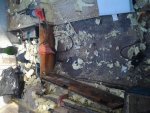Re: 1994 Chaparral 230 rebuild thread
So what are your thoughts on the issue? I have searched on here quite a bit and keep running into a multitude of thoughts and opinions. Some don't seem to feel its needed as its really only required on boats under 20'. Some dont like it at all as they feel it trapps water. Some dont want the expense of replacing it so they use foam noodles or jugs etc.
Some dont use anything.
some think its necessary as it may keep you afloat if you are swamped or leave the plug out. Some like that it could add structural ridgity and sound dampening.
The only conclusing I can come to so far is that if I have the typical 2lb foam it is most likely not there for the structure as I dont think they made 2lb foam for adding any ridgity. I can see how it would provide sound dampening.
Swamping is only one scenario where boats get into trouble. I'd highly recommend you rethink and investigate the foam issue further.
So what are your thoughts on the issue? I have searched on here quite a bit and keep running into a multitude of thoughts and opinions. Some don't seem to feel its needed as its really only required on boats under 20'. Some dont like it at all as they feel it trapps water. Some dont want the expense of replacing it so they use foam noodles or jugs etc.
Some dont use anything.
some think its necessary as it may keep you afloat if you are swamped or leave the plug out. Some like that it could add structural ridgity and sound dampening.
The only conclusing I can come to so far is that if I have the typical 2lb foam it is most likely not there for the structure as I dont think they made 2lb foam for adding any ridgity. I can see how it would provide sound dampening.




















